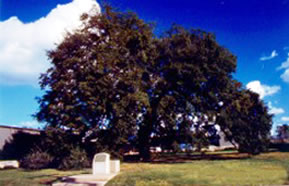RICHARDSON, Texas (March 4, 2005) – When The University of Texas at Dallas (UTD) accepts delivery this spring of its first mace – the ceremonial staff of authority that administrators and faculty at universities around the world carry before them at commencements and convocations – the object will incorporate elements of Texas’ colorful history and its promising future.
The mace will be fashioned from wood from the 600-year-old Treaty Oak Tree in Austin, beneath which Stephen F. Austin is reputed to have signed the first boundary agreement between Texas settlers and Native Americans. It will also contain a metal disk taken from an instrument package, built at UTD, that once flew on the Space Shuttle, as well as the seal of the university.
This spring UTD will accept its first mace, the ceremonial staff of authority that administrators and faculty carry before them at commencements and convocations. The mace will be fashioned from the 600-year-old Treaty Oak Tree in Austin.

“The mace will contain something of Texas’ past and something of its future,” said Dr. J. Michael Coleman, associate provost and dean of undergraduate education, who will lead a group of UTD representatives to the state capital today to take possession of a sizeable piece of the historic tree. “We hope the mace becomes an important new tradition at UTD.”
The mace, normally made of wood and clad in metal, has its roots in Medieval times, when it was used as a weapon to knock an enemy off his horse or crush his suit of armor. As its usefulness as a weapon waned, it became a symbol of authority or office, and is used throughout academia and government. Both the U.S. House of Representatives and the British House of Commons have ceremonial maces.
“We’ve talked about it for at least a decade, but it never got off the ground,” Coleman said. “Now, thanks to added impetus from our faculty and students, and in particular student government president Laura Rasheedi, the project is coming to fruition.”
Coleman believes that the mace will be an important addition to UTD, particularly since the university is so young.
“We need more ceremonial features at official events like graduation,” said Coleman, who earned his Ph.D. degree from the University of Virginia, where “the hand of Thomas Jefferson” (the university’s founder) could be seen throughout the campus. “Symbolism, ceremony and tradition are important to a university, and we hope that the mace will provide UTD some of that.”
Coleman came up with the idea of crafting the staff from the Treaty Oak because “it’s an important relic of Texas’ storied past.”
The once majestic tree is the sole survivor of what was known as the Council Oaks, a grove of 14 trees that, according to legend, served as a meeting place for Natives Americans in the Austin area. Tragically, in 1989 a deliberate poisoning destroyed much of the Treaty Oak. While the tree survived, it had to be dramatically trimmed back, and the wood salvaged from the tree has since been fashioned into works of art and other items – and shortly, the UTD mace.
Late this morning, Coleman and his UTD colleagues will visit the City of Austin Parks and Recreation Department, custodians of the remaining Treaty Oak wood, searching out a limb five feet in length and six inches in diameter. Once a selection is made, Southwest Airlines has agreed to transport the wood on a flight this afternoon to Dallas free of charge.
While the staff made from the Treaty Oak will represent the past, a wafer of metal taken from an instrument flown in space to be incorporated into the head of the mace will signify the future. Since its inception in 1969, UTD has had a highly regarded space sciences program, whose faculty and researchers have constructed scores of scientific instruments carried aboard manned and unmanned spacecraft into earth orbit and beyond, including missions to the Moon, Venus and Mars. This particular piece of metal was part of an experiment that flew on the Space Shuttle Endeavor in September of 1995.
When finished, Coleman estimated the mace will be four feet tall, with a head five and one-half inches wide.
Coleman isn’t certain who will construct the mace – a company based in Dayton, Ohio, that may be the sole remaining firm in the nation to build such items, or a local artisan. However, he would like to have it finished in time for the next commencement in May, where it will precede the unversity’s president in a procession of administrators and faculty members past hundreds of new graduates and their families.
About UTD
The University of Texas at Dallas, located at the convergence of Richardson, Plano and Dallas in the heart of the complex of major multinational technology corporations known as the Telecom Corridor®, enrolls more than 14,000 students. The school’s freshman class traditionally stands at the forefront of Texas state universities in terms of average SAT scores. The university offers a broad assortment of bachelor’s, master’s and doctoral degree programs. For additional information about UTD, please visit the university’s web site at www.utdallas.edu.